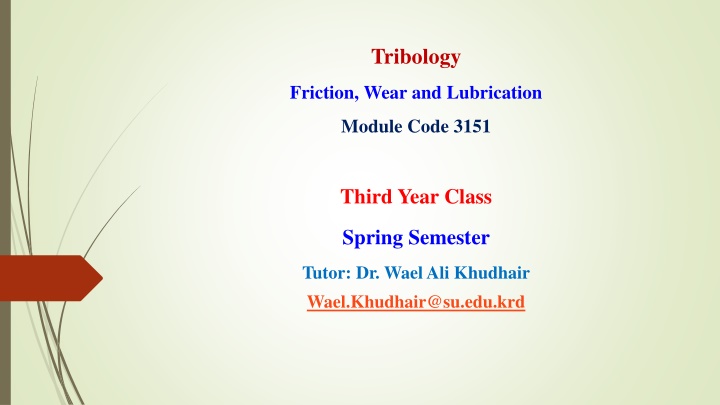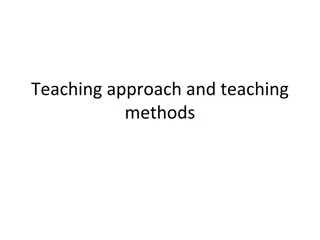
Tribology: Friction, Wear, and Lubrication in Mechanical Systems
Explore the fundamentals of tribology, the study of interacting surfaces in motion, encompassing friction, wear, lubrication, and bearing design. Learn how these factors impact mechanical systems, affecting efficiency, performance, and reliability across various industries.
Download Presentation

Please find below an Image/Link to download the presentation.
The content on the website is provided AS IS for your information and personal use only. It may not be sold, licensed, or shared on other websites without obtaining consent from the author. If you encounter any issues during the download, it is possible that the publisher has removed the file from their server.
You are allowed to download the files provided on this website for personal or commercial use, subject to the condition that they are used lawfully. All files are the property of their respective owners.
The content on the website is provided AS IS for your information and personal use only. It may not be sold, licensed, or shared on other websites without obtaining consent from the author.
E N D
Presentation Transcript
Tribology Friction, Wear and Lubrication Module Code 3151 Third Year Class Spring Semester Tutor: Dr. Wael Ali Khudhair Wael.Khudhair@su.edu.krd
Chapter 1: Introduction Definition Tribology, is defined as the branch of science and technology concerned with interacting surfaces in relative motion and with associated matters , and includes the study of friction, wear, lubrication and the design of bearings. The word tribology (from the Greek: = rubbing or attrition) Mechanical systems in which surfaces do not slide or roll against each other are rare, and tribology is therefore a key enabling technology with very wide application. Advances in tribology have underpinned much of the world s engineering progress. Its reach extends to all aspects of modern technology, from transport and engineering, food science and cosmetics. power generation to medical
Friction Friction may be defined as the resistance force encountered by on body in moving over another. Friction does play a central role in the performance of many mechanical systems. In some cases, low friction is desirable and even essential. The satisfactory operation of joints, for example, whether hinges on doors, human hip joints or bridge supports, demands a low friction force. Work done in overcoming friction in bearings and gears in machines is dissipated as heat, and by reducing friction we can achieve an increase in overall efficiency. But low friction is not necessarily beneficial in all cases. In brakes and clutches, adequate and controlled friction is essential to dissipate kinetic energy and transfer torque. High friction is similarly desirable between a vehicle tire and the road surface, just as it is between the human foot and the ground for walking.
Wear Wear will occur ,whenever surfaces move over each other, causing damage to one or both surfaces, generally involving progressive loss of material. Sometimes the wear is imperceptibly slight, but it can also be extremely rapid. In most cases, wear is detrimental perhaps causing: - 1. increased clearances between the moving components. 2. unwanted freedom of movement. 3. loss of precision. 4. It often leads to vibration, to increased mechanical loading and yet more rapid wear, and sometimes to fatigue failure. The loss by wear of relatively small amounts of material can be enough to cause complete failure of large and complex machines, and there are unfortunately cases where the root causes of major engineering disasters can be traced back to wear.
Wear High wear rate , however, are sometimes desirable. Grinding and polishing, processes that employ wear to manner. for example, are widely used manufacturing remove material in a controlled An initial small amount of wear is often anticipated and even welcomed during the running-in process in some kinds of machinery.
Lubrication Lubrication is considered as a key method of reducing friction, and often also wear, and the study of lubrication is very closely related to that of friction and wear. Even when an artificial lubricant is not added to a system, components of the surrounding atmosphere (especially the oxygen and water vapor in the air) often play a similar role and must be considered in any study of the interaction of the surfaces.
Junction Growth Theory Determining coefficient of friction using Solid Mechanics (Junction Growth) ??+ ?? ? ??+ ?? ? ? )?+??? ??,?= ( When ??= ? , ??= ??/?? and ???= ??/?? ?? ?+ (?? ?)?+??? - - - - - (1) ????= Where ??is the first principal stress and ?? is element area ?? ? (?? ?)?+??? - - - - - (2) ????= Where ??is the second principal stress
Junction Growth Theory ? ?? ? + ??? ?? ?? ?? = ? If yield strength of the material is ??= ?? ?? and shear strength ??= ?.? ?? (?? ?)?+ ??? then ??.??= since ??and 2 are constants then F = f (A) ???? that means Friction increase area of contact Area of contact will increase with increasing friction force, till the force reaches its limiting value.
Limiting Junction Growth Assume ??is shear stress of fractured interface ?????????= ??Amax ? ???????? ? ? = (?? ?)?+??? since ??.??= ?= (? ??.???? Then ?)?+ ( ? ??? .??)? (? ??? .?? ) ? = ? ?? ???.??? ? ?? ?? ?.? ? = = ( (?? ? ?? ? ??)? ? ? ??
Limiting Junction Growth Observation Ratio of shear strength decides (coefficient of friction) By doing some calculations ??/ ?? 1 0.005 10 0.050 20 30 40 50 60 70 80 90 99 0.102 0.157 0.218 0.289 0.375 0.490 0.667 1.032 3.509
How to reduce Junction Growth Contamination : - A few molecules thick oxide layer (encountered with metals in air) on the surface can reduce the friction (i.e., = 0.1 to 0.3 ) .
How to reduce Junction Growth Observation: - Rough surface ( Rq 0.2 m ) may damage protective layers. Weak (ductile) metal, Weak Oxide (1) - Film easily broken, rapid junction growth and high . Example: Indium , Gold. Weak Metal, Strong Oxide (2) - Transition from low to high as load increase Example: Copper , Iron. Strong Metal, Strong Oxide (3) - Low at all loads. Example: Strong steel , Chromium.
How to reduce Junction Growth Note: - Both Junction growth and ploughing (two / three) effects play role, and either of them may dominated friction behavior. Lubricant : Presence of lubricant reduces chances of Junction. Use of Suitable Contacting Materials - Using Soft (lesser shear strength, but high hardness) materials result in low shear strength of interface. - Never use same metal or closely metals in tribo-pair. copper on copper = 1.0 Aluminum low carbon steel = 0.8 Silver low carbon steel = 0.3
How to reduce Junction Growth Ductility : Use materials of limited ductility. - These materials after a small amount of junction growth will fracture rather than flow further.
Wear Defining Wear : Undesirable removal of material from operating solid surfaces by:- - Solid the working parameters are Load , Velocity , Environment and Materials Fluid ( liquid / gas ) parameters are Velocity, Pressure, Environment and Materials Wear Increases 1. Power losses 2. Oil consumption 3. Rate of component replacement
Wear Wear Mechanisms There are more than 35 Mechanisms Abrasive Wear - Polishing, Scouring , Scratching, Grinding, Gouging , - - - Adhesive Wear - galling , scuffing, scoring Cavitation ( localized impact of fluid against a surface during the collapse of bubbles Corrosive Wear ( chemical nature) Erosive Wear (impact of particles against a solid surface) Fatigue (Delamination) Fretting Wear (between bolt and nut)
Abrasive Wear Abrasive wear caused by the passage of relatively hard particles / asperities over a surface. Micro cutting: - Sharp particle or hard asperity cuts the softer. Cut material is removed as wear debris. Micro fracture: - Abraded material is brittle, e.g., ceramic. Fracture of the worn surface occurs due to merging of a number of smaller cracks. Micro fatigue: - When a ductile material is abraded by a blunt particle/asperity then cutting is unlikely and worn surface is repeatedly loaded and unloaded
Abrasive Wear Removal of material grains: - Happens in materials (i.e. ceramics) having relatively weak grain boundaries. Two basic modes of abrasive wear are: - Two body abrasion o o Three body abrasion
2-Body Abrasion Two interacting asperities in physical contact, and one of them is harder than other. Example polishing by emery paper. Normal load causes penetration of harder asperities into softer surface thus producing plastic deformation. To slide, the material is displaced/removed from the softer surface by combined action of micro ploughing and micro cutting.






